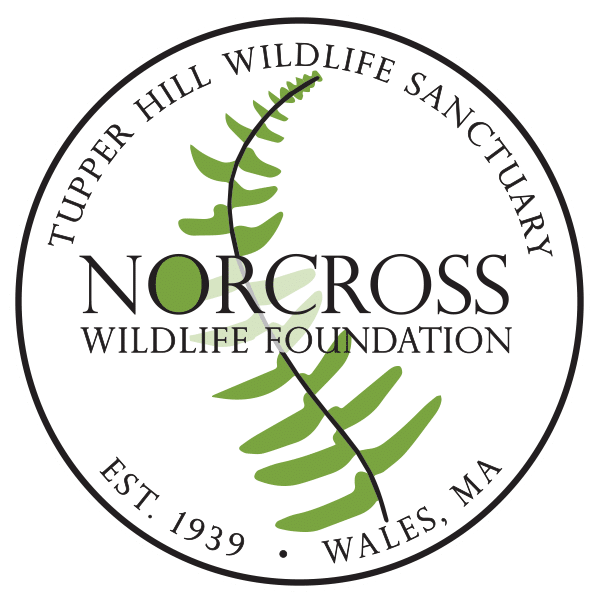The Norcross Wildlife Foundation, Inc., has its offices at the entrance to the original “Tupper Hill” wildlife sanctuary first begun by Arthur D. Norcross in 1939. This land, in the current towns of Wales and Monson, Massachusetts, and Stafford, Connecticut, is part of the homeland of the Native American Nipmuc Tribe whose traditional territory stretched across the “fresh water” headwater drainages of the Chicopee, Quinebaug, Shetucket, Blackstone, Charles, Concord and Nashua Rivers in what are today the states of Massachusetts and Connecticut. The Nipmuc tribe continues to exist today and its members live throughout this region and beyond.
During the period of the early 1700s and through the early 20th century this region was marked by the clearance of forests and conversion of wetlands for timber and agricultural purposes, by the damming of streams and rivers to create ponds for mill power and other purposes, by the construction of roads, farms, fences and stone walls, and the heavy extraction of natural resources. Many species of plant and animal wildlife, such as beaver and deer, were almost entirely eliminated from the region. As industrial and intensive agricultural production moved away to other regions of the U.S. and the world in the late 1800s the forests of the region began to grow back, and with this some of the wildlife has begun to return as well.
Born in 1895 in near-by Monson, Massachusetts, Arthur D. Norcross grew up exploring the woods and wetlands of the rural region that is today the home of the Norcross Wildlife Foundation. He saw active duty in World War I and was an avid outdoorsman who loved fishing and hunting big game. Following his war service, he founded the Norcross Greeting Card Company with his sister June and relocated to New York City where he would live the remainder of his life .
In 1939 he began to build his vision of a wildlife sanctuary, centered on a 100-acre plot of land in Wales which he had inherited from his late father in 1916. By 1964m his wildlife sanctuary Sanctuary, which he referred to as “Tupper Hill”m after the hill on which his first parcel of land was located, had grown to approximately 3,000 acres. During the intervening years Norcross oversaw an effort to shape the Sanctuary to his own vision, including the construction of 25 miles of roads, the construction of 4 major dams to create ponds, modifications to wetlands and waterways, the opening and planting of “grain patches” to feed wildlife, and the creation of a variety of experimental gardens and other interventions to “benefit” wildlife.
In the late 1960s Norcross looked back on his work and noted that his wildlife sanctuary at Tupper Hill was to serve as “…a place of refuge where all wildlife is encouraged not just to survive but also to proliferate naturally, and where certain species, now threatened with extinction, may again attain more normal distribution and benefit the public by their survival.”
By creating the Norcross Wildlife Foundation in 1964, Arthur helped to ensure that his vision and work would be continued into the future. With his death in 1969, the management of the Foundation, today a 501(c)3 private operating foundation, passed to its Board of Directors and staff. The Foundation is governed through its Board of Directors by its articles of incorporation filed with the Attorneys General of the State of New York and the Commonwealth of Massachusetts, by its own By-Laws and policies, and all relevant local, state, and federal laws and regulations.
Today the Norcross Wildlife Foundation manages the land it cares for in keeping with Arthur Norcross’s original vision, preserving natural lands that support native plants and animals and a robust and resilient regional ecosystem. The Foundation stewards this land for the public benefit through the clean air and water, storm water control and temperature regulation that natural land provides to the region, through biodiversity conservation, and through our public and educational programs for all communities of the region.
